
The superb fruit dove, also known as the purple-crowned fruit dove, is a medium-sized, colourful fruit-dove in the family Columbidae.
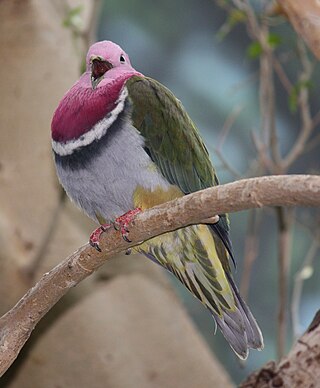
The pink-headed fruit dove also known as pink-necked fruit dove or Temminck's fruit pigeon, is a small colourful dove.

The black-chinned fruit dove, also known as the black-throated fruit dove or Leclancher's dove, is a medium-sized bird of the family Columbidae. The male is a colorful bird with a green belly and wings, a brown tail, a whitish grey head and neck with a purple base, red iris and a small black patch under its yellow bill. The female has a green head, neck and breast.
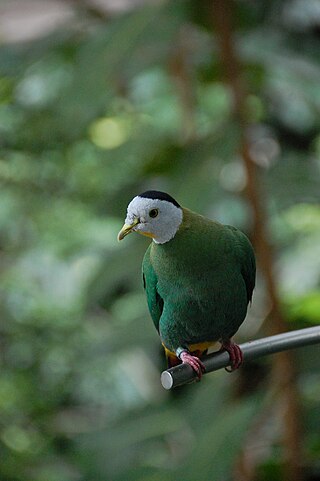
The black-naped fruit dove, also known as the black-headed fruit dove, is a medium-sized, up to 24 cm (9.4 in) long, green fruit dove with yellowish bill and iris. The male has a pale grey head with a black nape, yellow throat, and golden yellow and pink undertail coverts. The plumage of the female and the young is entirely green.

The beautiful fruit dove, also known as the rose-fronted pigeon or crimson-capped fruit dove, is a small, approximately 19 cm long, mainly green fruit dove. It has a red crown, whitish throat, a greenish-yellow bill and purplish-red feet. It has a blue-grey breast and yellowish orange belly, with a reddish purple patch in between. Both sexes are similar.

Wallace's fruit dove is a species of a bird in the pigeon family Columbidae. The name commemorates the British naturalist Alfred Russel Wallace. It is a rather large, long-tailed fruit dove with a length of 24–28 cm (9.4–11.0 in) and has been described as "one of the most beautiful" fruit doves. The forehead and crown are dull crimson, the lower face and throat are white, and the rest of the head, breast, neck, and upper back are pale bluish-grey. The wings and lower back are green and the belly is orange, separated from the chest by a white band. Both sexes look similar, but females have less extensive red on the head and a greenish tinge to their grey parts.

The rose-crowned fruit dove, also known as pink-capped fruit dove or Swainson's fruit dove, is a medium-sized fruit dove that is found in parts of southern Indonesia, northern Australia and eastern Australia.
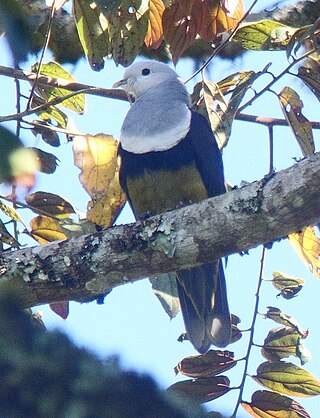
The banded fruit dove or black-backed fruit dove is a large pigeon with white head, neck and upper breast; black back and upperwing grading to grey on rump; black tail with broad grey terminal band; underparts grey, demarcated from white head.

The scarlet-breasted fruit dove is a species of bird in the family Columbidae. It is endemic to Indonesia, where it occurs in the northern Moluccas. Its natural habitat is subtropical or tropical moist lowland forests. It is rated as a species of least concern on the International Union for Conservation of Nature Red List of Endangered Species. In 1863 Hermann Schlegel named the new species for one of his collectors, Heinrich Agathon Bernstein.

The white-headed fruit dove is a species of bird in the pigeon family Columbidae. It was described by the English ornithologist John Gould in 1856, and the specific name eugeniae honours the French empress Eugénie de Montijo. Adults of the species have white heads, a purplish-red breast patch, a grey shoulder patch, olive-green upperparts, greenish underparts with a blue tinge, and a yellowish vent. Juveniles have green heads with the white restricted to the forehead and upper throat, a much smaller grey shoulder patch, and the red breast patch restricted to the centre of the breast.
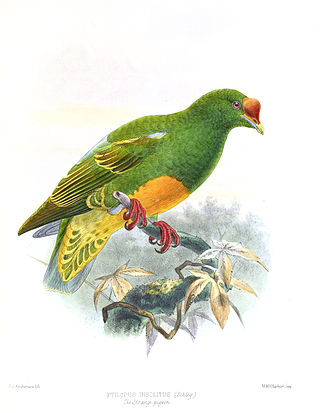
The knob-billed fruit dove is a species of bird in the family Columbidae. It is endemic to the Bismarck Archipelago.

The red-moustached fruit dove or moustached fruit dove is an extinct species of bird in the family Columbidae. It was endemic to French Polynesia. The last record was of the subspecies P. m. tristrami on Hiva Oa, in 1922. Its extinction has been attributed to predation by the introduced great horned owl, as well as by introduced rats and cats. In 1994, it was listed as an extinct species on the International Union for Conservation of Nature Red List of Endangered Species.

The ornate fruit dove is a species of bird in the family Columbidae. It is found in New Guinea. Its natural habitats are subtropical or tropical moist lowland forest and subtropical or tropical moist montane forest.

The Palau fruit dove is a species of bird in the family Columbidae. It is endemic to Palau and it is also Palau's national bird.

The pink-spotted fruit dove is a species of bird in the family Columbidae. It is found in forest and woodland in lowland and foothills of New Guinea and nearby smaller islands. It is widespread and generally common.

The many-colored fruit dove, also known as manuma in the Samoan language, is a species of bird in the family Columbidae. It occurs on islands in the south-west Pacific Ocean where it is found in Fiji, the Samoan Islands, and Tonga. Its natural habitat is subtropical or tropical moist lowland forests. Today, the birds are most often found in Fiji and Tonga. It usually feeds high in the canopy on fruit and berries, especially banyan fig. The nest is a small platform of twigs where one white egg is laid.
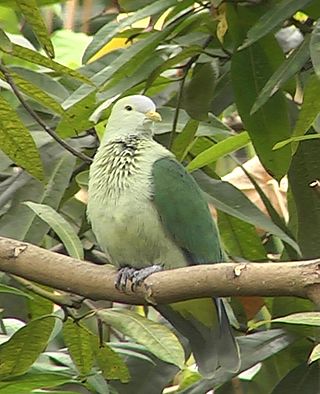
The grey-green fruit dove is a species of bird in the family Columbidae. It is endemic to the Society Islands in French Polynesia. Its natural habitat is subtropical or tropical moist lowland forests.

The black-banded fruit dove is a large pigeon with white head, neck and upper breast; black back and upperwing grading to grey on rump; black tail with broad grey terminal band; underparts grey, demarcated from white head and neck by broad black band.

The fruit doves, also known as fruit pigeons, are a genus (Ptilinopus) of birds in the pigeon and dove family (Columbidae). These colourful, frugivorous doves are found in forests and woodlands in Southeast Asia and Oceania. It is a large genus with over 50 species, some threatened or already extinct.
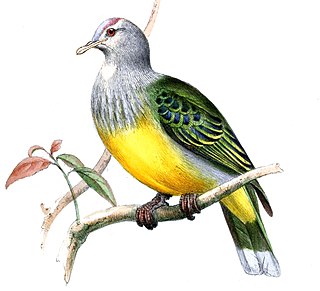
The Raiatea fruit dove is a species of bird in the family Columbidae. It is endemic to the Society Islands in French Polynesia. Although first named to science in 1853, this fruit dove was evidently discovered 30 years earlier, by René Primevère Lesson (1794–1849), while serving as naturalist aboard La Coquille. It was formerly considered a subspecies of the grey-green fruit dove but was split as a distinct species by the IOC in 2021. Its natural habitat is subtropical or tropical moist lowland forests.





















